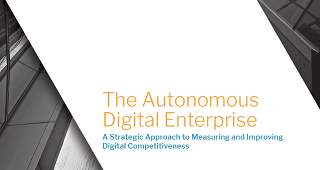If 2020 proved anything for the world of business, it’s that agility and resiliency are must-haves to thrive in the face of persistent disruption, and it’s helpful to see how we’re all doing collectively. To that end, the World Economic Forum even launched “The Great Reset” initiative for global stakeholders to cooperate as they simultaneously manage the direct consequences of the pandemic.
According to The 2021 State of IT Report from Spiceworks Ziff Davis, 76 percent of businesses are planning long-term IT changes. For many of those companies, pivoting toward automation and emerging technologies, or becoming an Autonomous Digital Enterprise (ADE), is the path forward. An ADE minimizes manual effort to capitalize on human creativity, skills, and intellect across the enterprise. In an effort to gauge where organizations are on their ADE evolutionary scale and measure their current and future digital competitiveness, BMC partnered with 451 Research, an S&P Company, to create the global ADE Index.
451 Research recently surveyed 1,200 business and IT decision-makers across 20 industry categories and 11 countries. The survey measured today’s ADE adoption rate, the perceived importance of each operating characteristic and technology-enabled tenet, and where respondents expect to be in two years.
Key findings
The current global ADE Index is 39.3 percent, which means that, on average, organizations practice a shade under two-fifths of what they need to be doing to become an ADE. Looking ahead two years, the 2022/23 global ADE Index increases to 46.1 percent, a net increase of 17.3 percent, but still a long way from full autonomy.
Over the next two to three years, organizations’ priorities among the operating models and technology-enabled tenets will shift in response to new market opportunities and business requirements. According to the Index, organizations are currently focused on the extraordinary amount of data generated by daily activities (Data-Driven Business), where and how to spend capital (Optimized Technology Buying), and how to categorize and organize various business entities (Digital Business Domains).
That’s not surprising, given that organizations of all stripes are navigating a global pandemic. Going forward, the focus shifts to more traditional strategic initiatives—ever-present cyber threats (Adaptive Cybersecurity) and a renewed focus on serving the customer at every touchpoint (Transcendent Customer Experience).
Measuring against the industry
The projected 17.3 percent jump in the global ADE Index over the next two years outpaces overall information communication technology (ICT) spending, which IDC forecasts will grow 12.7 percent over the same period. While digital transformation doesn’t automatically equal success, companies with a higher level of digital maturity are more likely to yield higher levels of net revenue growth and net profit margin—45 and 43 percent higher, according to Deloitte’s “Uncovering the connection between digital maturity and financial performance.” And a BCG study reveals that digital leaders achieve earnings growth that is 1.8 times higher than digital laggards.
Conclusion
The 451 research shows that organizations across the globe and in all industries are already aware of the benefits of agility, customer centricity, and actionable insights and the business imperative to continuously assess digital competitiveness. By empowering companies to understand how they rate among their rivals in the industries and markets they serve, they’re better prepared to make informed, insight-driven decisions about digital business strategy, operational structure, and technology investments. For more details, download the research paper, “The Autonomous Digital Enterprise: A Strategic Approach to Measuring and Improving Digital Competitiveness,”.






